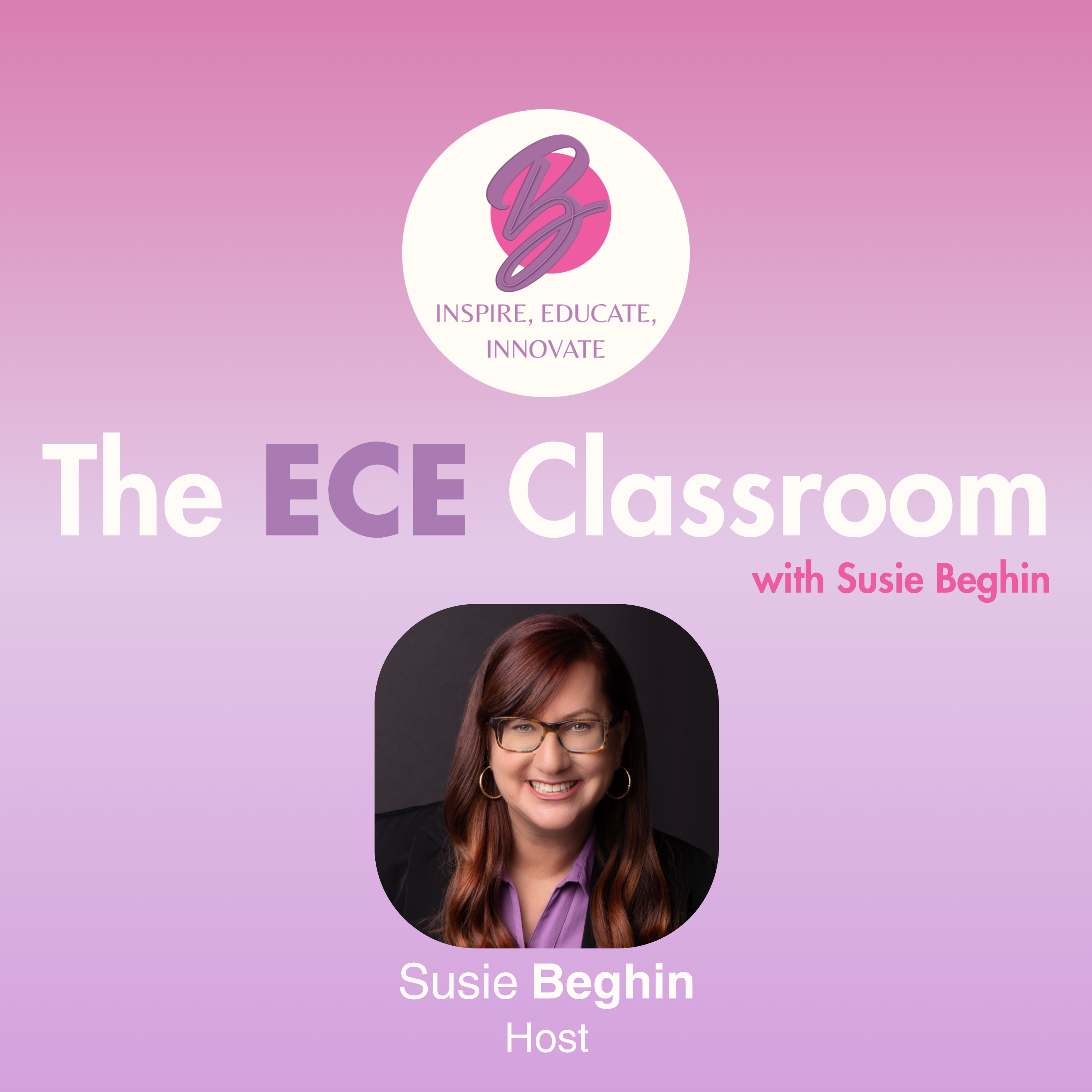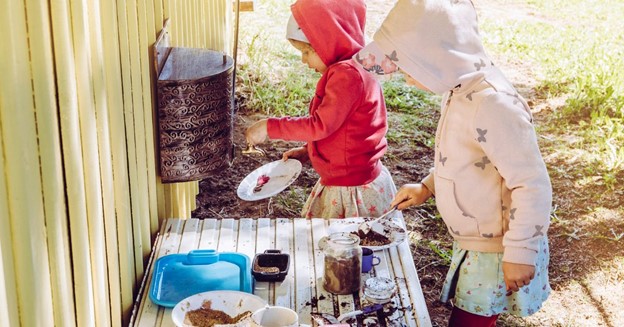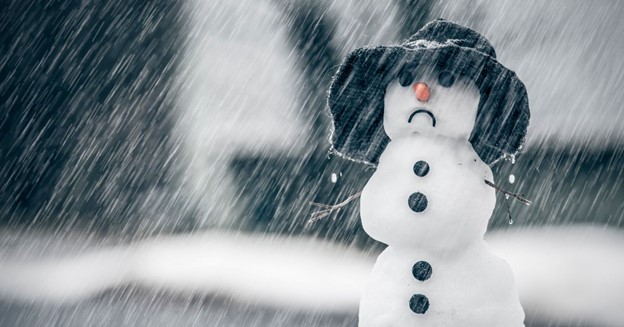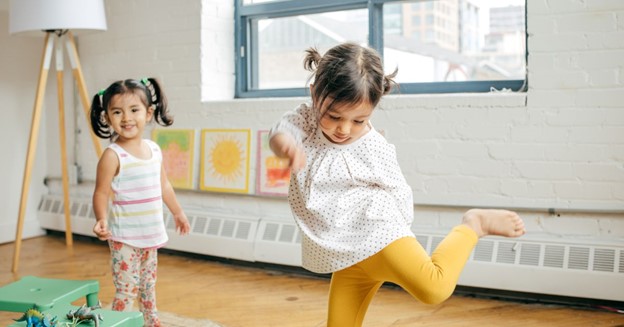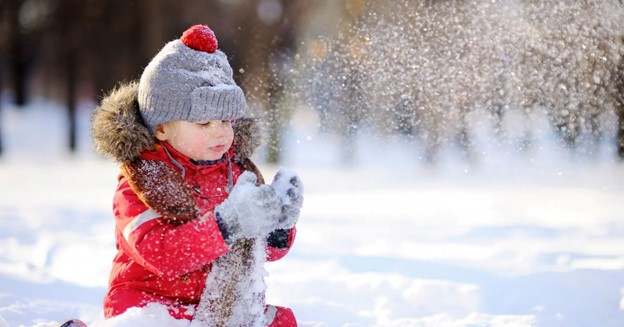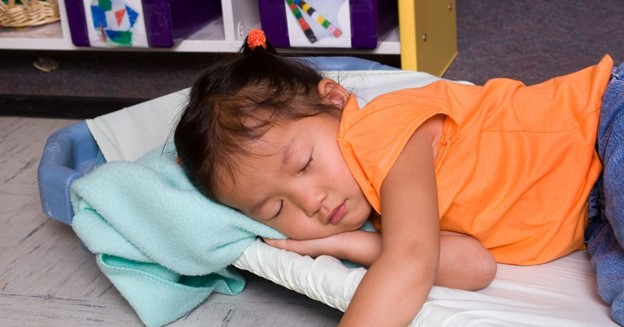Navigating the Transition: Helping an Older Sibling Adjust to a New Baby
Navigating the Transition: Helping an Older Sibling Adjust to a New Baby
by Susie Beghin, RECE, Founder of Alpha’s Discovery Kids
As both a mom and an early childhood educator, I understand the challenges families face when welcoming a new baby into the home. The arrival of a new sibling can be an exciting yet challenging time for older children, especially when it comes to adjusting to the changes in their daily routine and family dynamics. At Alpha’s Discovery Kids, we’re committed to supporting families at every stage of their journey, providing guidance and assistance to help children and parents navigate this transition with ease.
It’s not uncommon for children to experience a range of emotions during this time, and these feelings often manifest in their behavior at daycare. From regression in previously mastered skills to attention-seeking behaviors and separation anxiety, the changes happening at home can significantly affect a child’s behaviour and well-being in the daycare environment.
Here are five common observations we see in the daycare setting:
1.Child Regression in Skills:
- Children may regress in skills they’ve previously mastered. For example, a child who was once independent at nap time may suddenly need more help falling asleep.
2. Attention-Seeking Behavior:
- Some children may exhibit attention-seeking behavior in negative ways, such as whining, hitting, or biting, to garner more attention.
3. Separation Anxiety:
- Older siblings may experience strong separation anxiety at drop-off time, even if they’ve previously adjusted well to daycare.
4. Reluctance to Attend Daycare:
- Children may express a desire to stay at home with the parent rather than attending daycare.
5. Engagement in “Baby Talk”:
- Children may revert to “baby talk” even if they can speak in full sentences.

It’s crucial for parents to communicate these changes with their daycare teachers. Understanding the child’s situation at home enables us to provide the best support and assistance at daycare.
Here are some strategies you can try to help children adjust to the change:
Acknowledge the Child’s Feelings:
- Validating the child’s emotions is crucial. Let them know that it’s okay to feel sad, mad, or jealous about the new addition to the family. For example, you might say, “It’s hard to be a big sister! You sometimes feel sad or mad that mom and dad are busy with your little brother.”
Acknowledge Good Behavior:
- Children often seek attention, even if it’s negative. Instead of focusing on negative behavior, emphasize and praise positive behavior. For instance, you might say, “I like how you helped your little brother with his bath this morning,” or “I appreciate how you waited patiently for me to finish talking on the phone before you came to ask me something.” Specific praise encourages the child to repeat desirable behavior.
Avoid Making Big Changes:
- It’s advisable to avoid making other significant changes during this time. For instance, hold off on starting potty training or weaning. Minimizing changes can help the child adjust more smoothly.
Continue Treating the Child According to Their Age and Skill Level:
- If you notice regression in the child’s behavior, it’s essential to continue treating them according to their age and skill level. Offer opportunities for age-appropriate activities to help them build and maintain their skills.
With patience, understanding, and support, both parents and children can navigate this transition successfully. Enjoy this special time by spending extra one-on-one time with each other as well as quality time together as a family!
For video content on this topic and similar early childhood topics, visit our YouTube channel.
The ECE Classroom – New Podcast for early childhood educators
The ECE Classroom with Susie Beghin
by Susie Beghin, RECE, Founder of Alpha’s Discovery Kids
“Educators are the lifeblood of the early child care system.” – Susie Beghin
I am thrilled and excited to announce the launch of my brand new podcast, ‘The ECE Classroom with Susie Beghin.’ Dedicated to exploring key topics in early childhood education, each episode offers insightful discussions and practical advice and is designed to inspire, inform, and empower educators, home care providers, and parents alike. With my background in early childhood education and daycare ownership, I am passionate about nurturing young minds and supporting those who work tirelessly to shape the future generation.
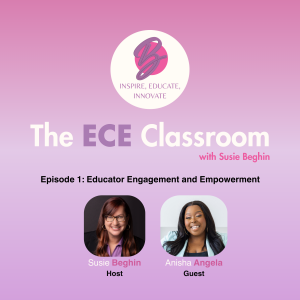
In our inaugural episode, I am delighted to welcome Anisha Angela as our guest speaker. Anisha is an Early Childhood Education (ECE) coach and expert with over 14+ years of experience in the field. Her extensive background includes leadership roles in childcare programs, teaching positions at college programs, and overseeing multiple childcare locations as a senior manager.
As the CEO and Founder of “The Early Childhood Coach + Co,” Anisha is committed to supporting the success of fellow ECE professionals through consulting, coaching, and training. With her wealth of knowledge and experience, Anisha shares invaluable insights into the current challenges facing educators, including burnout and stress, and offers practical tips for reigniting the spark within the classroom.
We hope you’ll join us on this journey of learning and growth as we strive to support and uplift the early childhood education community.
Listen to the podcast here: https://spotifyanchor-web.app.link/e/OPl10EGzNIb
Connect with Anisha on her social channels to stay updated on her insights and upcoming events:
Instagram: @anisha.theecc
Facebook: @AnishaAngella.co
Twitter: AnishaAngella.co (@AnishaAngella)
Youtube: Anisha Angella
Website: www.anishaangellabooks.ca
General Email: info@anishaangellabooks.ca
Spring Adventures for Kids: Exploring Nature
Spring Adventures for Kids: Exploring Nature
by Susie Beghin, RECE, Founder of Alpha’s Discovery Kids
As spring blooms and nature comes to life, it’s the perfect time to engage children in outdoor activities that foster their curiosity and creativity. At Alpha’s Discovery Kids, we’re passionate about providing children with enriching experiences that ignite their love for learning and exploration. From nature walks to mud kitchens, there are endless opportunities for kids to connect with the natural world and unleash their imagination.
Nature walks are a favourite among children and educators alike and are an excellent way to connect children with the natural world while encouraging physical activity and curiosity. During these walks, children have the chance to explore various environments, from wooded trails to open fields, collecting treasures along the way.

Encouraging children to collect items such as pine cones, stones, leaves, and twigs not only sparks their curiosity but also provides materials for creative projects. These collected treasures can be used in art projects, where children can create nature-inspired collages, paintings, or sculptures, fostering their artistic expression and appreciation for the beauty of the natural world. Picking up sticks, in particular, seems to captivate children’s attention as they experiment with different sizes and shapes, imagining them as wands, swords, or tools for building.
Parents can also join in on the fun by taking their children on nature walks in local parks or trails. Equipped with a bag to gather their findings, children delight in the opportunity to explore the great outdoors and discover the beauty of nature firsthand. Nature walks also offer opportunities for hands-on learning experiences. Children can observe different plant and animal species, learning about their habitats, behaviours, and life cycles. Parents can also engage children in discussions about the importance of conservation and caring for the environment, instilling in them a sense of responsibility towards the planet.
Another highlight of outdoor play is the mud kitchen, a beloved feature that encourages imaginative play, sensory exploration and hands-on learning. With simple setups consisting of tables or flat surfaces, pots, pans, and utensils, mud kitchens provide children with endless opportunities to cook, bake, and create. As children mix, pour, and stir ingredients in their mud kitchens to concoct “delicious” meals and potions, children engage in open-ended play that fosters language development, motor skills, and social interaction.
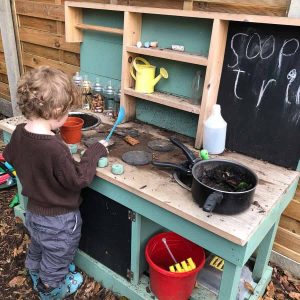
Mud kitchens have benefits beyond imaginative play. As children engage in sensory activities, they explore different textures, smells, and consistencies, enhancing their sensory processing skills. Mixing and stirring promotes hand-eye coordination and strengthens hand muscles, laying the foundation for writing and other fine motor tasks. The sensory experience of squishing mud between their fingers and the freedom to experiment with different textures and consistencies stimulates their senses and ignites their creativity. And, the outdoor setting provides children with the opportunity to engage in physical activity, promoting gross motor skills and overall well-being.
Additionally, mud kitchens offer rich learning experiences that integrate various academic disciplines including our 4 Pillars of Learning. Children naturally engage in scientific inquiry as they observe changes in materials and explore cause-and-effect relationships. Children can integrate elements of mathematics by counting, sorting, and categorizing natural materials or measuring quantities for their concoctions. They also exercise their creativity and artistic skills as they experiment with different combinations and designs, transforming mud and natural materials into works of art.
Whether exploring the wonders of nature on a walk or whipping up culinary delights in the mud kitchen, springtime offers abundant opportunities for children to learn, grow, and connect with the world around them. By embracing outdoor play and nature-based activities, we cultivate a sense of wonder and curiosity that will inspire children to explore and discover throughout their lives.
For more information, visit our YouTube channel for inspiration and ideas.
Parenting in the Digital Age: Screen Time
Parenting in the Digital Age: Screen Time
by Susie Beghin, RECE, Founder of Alpha’s Discovery Kids
Parenting in the digital age can feel like navigating uncharted territory. As a parent and the owner of Alpha’s Discovery Kids, I am acutely aware of the complexities involved in raising children in an era dominated by technology. In our rapidly evolving world, where digital devices are part of our everyday lives, finding the right balance between harnessing the benefits of technology and safeguarding against its potential drawbacks is crucial. At Alpha’s Discovery Kids, we prioritize creating an environment where children can thrive emotionally, socially, and intellectually while also recognizing the role that technology plays in their lives. Striking this balance is essential as we help guide children through their formative years.
One of the most pressing concerns for parents is managing screen time limits. With smartphones, tablets, and other digital devices becoming increasingly prevalent, children are spending more time than ever in front of screens. This is why it’s so important to focus on creating a balance between embracing technology for educational purposes and ensuring children have ample opportunities for real-world experiences and interactions. After all, children learn best through play so we want to make sure we are encouraging them to participate in activities such as outdoor play, social interactions and creativity.

Quality of content is another major consideration for parents navigating the digital landscape. With countless apps, games, and digital platforms available to children, it’s essential to curate content that is not only entertaining but also enriching, age-appropriate, and safe. Parents must discern between educational content that fosters learning and critical thinking skills and potentially harmful or addictive material. It’s equally important to make sure that the digital content aligns with family values and educational goals – just one more layer of complexity to the decision-making process!
The impact of technology on children’s social and physical development also cannot be overlooked. Excessive screen time has been linked to a sedentary lifestyle, which can contribute to a decline in physical activity and overall well-being. Additionally, prolonged use of digital devices can sometimes replace face-to-face interactions, affecting children’s social skills and emotional development.
Despite these challenges, we believe that technology can be a valuable tool when used appropriately. At Alpha’s Discovery Kids, we incorporate technology into our curriculum in a way that enhances learning experiences and fosters creativity, striving to provide children with opportunities to engage with technology in meaningful ways.
We also encourage open communication about technology. By discussing the benefits and potential drawbacks of technology with children, parents can help them develop healthy digital habits and make informed choices about their screen usage.
Ultimately, parenting in the digital age requires a thoughtful and proactive approach. By creating a balance between technology and real-world experiences, setting clear guidelines for screen time, and fostering open communication, parents can help their children navigate the digital world safely and confidently. At Alpha’s Discovery Kids, we are committed to supporting parents in this journey and providing children with the tools they need to thrive in today’s digital age.
For more information on early childhood topics, follow Susie Beghin’s YouTube channel where she delves deeper into these topics.
Fostering Early Literacy: Strategies to Inspire a Love of Reading
Fostering Early Literacy: Strategies to Inspire a Love of Reading
by Susie Beghin, RECE, Founder of Alpha’s Discovery Kids
Did you know that the foundation for a lifelong love of reading is laid in the earliest years of childhood?
As an Early Childhood Educator and a mother, I am deeply passionate about fostering a love for reading from an early age. At Alpha’s Discovery Kids, we are always exploring natural ways to incorporate language and literacy into our play-based approach to learning. After all, research indicates that the peak ability to learn occurs between the ages of 0 to 6 years, so building strong literacy skills in the early years is crucial for a child’s overall development. The key is incorporating various strategies to make learning enjoyable and effective.
Teaching literacy through free play is one of the most effective ways to engage children and foster a love for reading, and something we do every day at Alphas Discovery Kids! By creating a “print-rich” environment, we surround children with written words and labels that correspond to everyday objects. For example, labeling items with both a picture and written word helps children make associations between the spoken word and its written form. Whenever we engage with these labeled items during work time, we point out the written word, reinforcing the connection between spoken language and print.
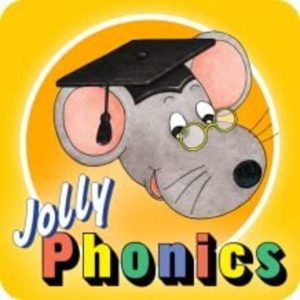
In addition to labeling, we use Jolly Phonics songs as a fun and engaging way to develop associations between letter sounds and letter names. Singing alphabet songs or rhymes helps children become familiar with the sounds of letters while providing a memorable and enjoyable experience.
When it comes to reading books, we believe in making the experience interactive and engaging. Instead of simply reading aloud, we encourage children to participate by asking them questions about the story and what they think will happen next. This not only promotes critical thinking skills but also encourages children to actively engage with the text and develop comprehension skills.
We can also empower children to tell their own stories by interpreting pictures on a page or creating their own narratives based on the illustrations. This encourages creativity and imagination while also strengthening language and storytelling abilities.
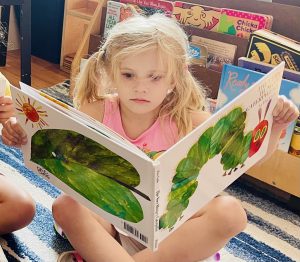 Intentional literacy activities can be tailored to suit children at different stages of development. For infants, daily read-aloud sessions provide valuable opportunities for brain development and foster a sense of curiosity about the world. As children transition into the toddler stage, tactile activities such as using alphabet magnets or drawing letters in sand help introduce them to the alphabet in a hands-on way. A quick tip is to start with 5 to 7 letters and gradually add more as children learn. This ensures that they can build upon their knowledge at a pace that suits them.
Intentional literacy activities can be tailored to suit children at different stages of development. For infants, daily read-aloud sessions provide valuable opportunities for brain development and foster a sense of curiosity about the world. As children transition into the toddler stage, tactile activities such as using alphabet magnets or drawing letters in sand help introduce them to the alphabet in a hands-on way. A quick tip is to start with 5 to 7 letters and gradually add more as children learn. This ensures that they can build upon their knowledge at a pace that suits them.
For preschoolers, we introduce the alphabet scavenger hunt as a fun and interactive way to reinforce letter recognition and early literacy skills. Children are encouraged to search for objects that begin with specific letters, promoting active engagement and exploration while strengthening their understanding of the alphabet.
By incorporating these strategies into our curriculum at Alpha’s Discovery Kids, we aim to instill a lifelong love for reading and learning in children from a young age. By making literacy fun, interactive, and accessible, we empower children to become confident and enthusiastic readers, setting them up for success in school and beyond.
For more information about this and other early childhood education topics, check out our YouTube videos.
Embracing Winter: Battling the Blues
Embracing Winter: Battling the Blues
by Susie Beghin, RECE, Founder of Alpha’s Discovery Kids
As we get to the end of February in a cold climate, it’s not uncommon for adults to find themselves grappling with the winter blues. Unlike children, many adults shudder at the thought of heading out into the frigid temperatures. Paired with the often grey skies, winters can be a struggle for many people. However, at Alpha’s Discovery Kids, we believe that with a mindful approach, parents can not only navigate but also turn the winter season into a time of warmth, connection, and family well-being.
Here’s some tips to help battle those winter blues:
- Outdoor Adventures:
Many adults look at winter as a period of hibernation. But venturing outdoors, even in colder temperatures, can significantly impact your mood and overall well-being. Make it a family affair—whether it’s building snow forts, taking a winter hike, or engaging in a friendly snowball fight, these outdoor activities offer an excellent way to bond with your children while boosting everyone’s spirits.
- Dress for the Occasion:
Don’t let the chill keep you indoors. Equip yourself and your family with the appropriate winter gear. Bundle up in layers, ensuring warmth and comfort during your outdoor excursions. The simple act of dressing for the weather can make the outdoors more inviting, allowing you (and your children) to fully enjoy the wonders of the winter landscape.
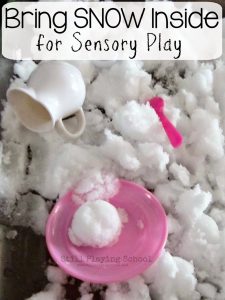
- Create a Winter Wonderland at Home:
Sometimes, the best adventures are closer than you think. Transform your home into a cozy winter haven. Get creative with indoor activities, exploring snow indoors (yes it’s possible), baking seasonal treats, or even having a family movie night with films that celebrate the magic of winter. By bringing the warmth indoors, you create a nurturing environment that counters the chill outside.
- Mindful Moments:
Winter provides a unique opportunity for mindfulness. Encourage quiet moments of reflection, perhaps by the fireplace or with a warm cup of cocoa. Incorporate mindfulness practices into your routine, such as deep breathing or simple meditation. These moments of calm can be grounding, fostering a sense of peace and emotional well-being.
- Stay Connected:
Winter blues often come with a sense of isolation. Combat this by staying connected with friends and family. Plan winter-themed gatherings or virtual meet-ups. Building a sense of community, even from a distance, can alleviate feelings of loneliness and contribute to a more positive winter experience.
- Plan for Physical Activity:
Physical activity is a powerful tool in combating the blues. Plan regular exercise sessions, whether it’s indoor workouts, winter sports, or simple stretching routines. Not only does this boost your mood, but it also sets a positive example for your children, instilling the value of staying active even during the colder months.
By taking a proactive and family-centered approach, parents can turn the winter season into a time of connection, joy, and shared experiences. At Alpha’s Discovery Kids, we recognize the importance of family well-being, and we encourage parents to see the beauty and warmth that winter can bring when approached with a positive mindset. Let this winter be a season of togetherness, creating lasting memories that your family will cherish.
For more information and early childhood tips, follow Susie Beghin on YouTube.
Winter Activities for Kids: Keeping Kids Active and Engaged
Winter Activities for Kids: Keeping Kids Active and Engaged
by Susie Beghin, RECE, Founder of Alpha’s Discovery Kids
As a mother and early childhood educator, I have witnessed the transformative influence that offering children a well-rounded educational journey can have. And at Alpha’s Discovery Kids, our commitment to giving children the best start in life is embodied in our 4 Pillars of Learning. These pillars, including Language & Literacy, STEAM, Physical Activity & Nutrition, and Mindful Awareness, form the foundation for providing children with the best start in life.
Among these pillars, Physical Activity & Nutrition hold a special place. It’s not merely about keeping young bodies in motion; it’s a holistic approach that nurtures the mind and promotes overall well-being. Even during the winter months, when the cold might tempt us to stay indoors, incorporating physical activity remains key.

Cold weather doesn’t have to mean a halt to outdoor play. At Alpha’s Discovery Kids, we recognize the importance of engaging children in physical activities, even when the temperature drops. The benefits of physical activity extend far beyond the obvious physical advantages. While it undoubtedly promotes physical health by enhancing bodily functions, building strength, and supporting the development of bones and muscles, its impact on mental and emotional health is equally significant. Physical activity has been shown to elevate mood, reduce stress, and foster a positive mindset from an early age.
And although, as adults, we don’t always enjoy heading out into the cold, most children tend to love it! Winter provides unique opportunities for physical activities that are not only enjoyable for children but also contribute to their development. Sledding, snowball fights, and building snowmen are not just recreational; they enhance gross motor skills, encourage teamwork, and promote creativity. These activities keep kids active and contribute to their social and emotional growth.
In addition to outdoor play, indoor physical activities are equally important during the winter. Parents play a pivotal role in encouraging physical activity at home, especially when outdoor play might be limited. On days when heading outdoors is challenging, there are numerous indoor activities that you and your child can enjoy, all with household items you likely already have. Here are a few ideas:
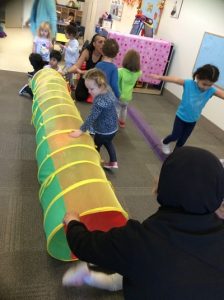
- Magical boxes – Provide your child with a large box and witness its transformation into fire trucks, tunnels, or a fantastic canvas for painting.
- Pillow paradise – Pillows can be more than just for resting. Try crafting an obstacle course or a cozy pillow fort for endless fun.
- Dance party extravaganza – Discover music the whole family enjoys and let loose with a dance party. It’s a fantastic way to get everyone moving and grooving.
- Scavenger hunt quest – Get creative with hiding spots and organize an entertaining scavenger hunt.
- Family flex– Engage in easy stretching exercises suitable for the entire family. It’s a great way to stay active and flexible.
These indoor activities not only keep your children physically active but also incorporate elements from the STEAM pillar (Science, Technology, Engineering, Art, and Math). Building a pillow or blanket fortress enhances engineering skills, and using a box as a canvas introduces artistic elements. Beyond the physical benefits, these activities stimulate young minds and foster a love for learning.
As winter sets in, don’t let it dull the sparkle of your kids’ activity. Integrating physical activity into their routine, even during the colder months, has a profound positive impact. The key is to make it fun and seamlessly woven into daily life. So, let’s embrace the winter wonderland and ensure that, even in the cold, our children are active and engaged.
For more early childhood education tips , check out my YouTube videos.
Winter Safety Tips for Kids: Keeping Your Little Ones Cozy and Secure
Winter Safety Tips for Kids: Keeping Your Little Ones Cozy and Secure
by Susie Beghin, RECE, Founder of Alpha’s Discovery Kids
As parents, caregivers, and educators at Alpha’s Discovery Kids, our goal is to provide children with the best possible start in life. We understand the importance of guiding and supporting them in various aspects, especially when it comes to their safety. When winter sets in and our surroundings become blanketed in snow, it’s crucial to ensure that our children are not only warm and comfortable but also safe during outdoor activities.
At Alpha’s Discovery Kids, children are encouraged to play outdoors for two hours per day, even during the winter months, unless the weather conditions are deemed unsafe. This time spent outdoors is invaluable for their physical well-being, social development, and connection with the world around them. However, for this outdoor adventure to be both fun and secure, it’s important to keep a few winter safety tips in mind.

Dress your children appropriately for the weather
Ensuring your children are appropriately dressed for the weather is crucial and layers are key. Layering allows your child to adjust their clothing according to the temperature and their activity level. When it’s cold outside, those multiple layers act as a thermal barrier, trapping warm air close to the body while shielding against the chilling winds. Proper winter attire should include a warm base layer, an insulating layer to keep them cozy, and a waterproof and windproof outer layer. Don’t forget to cover the extremities, too; warm mittens or gloves, a snug hat, and insulated, waterproof boots will keep your child’s fingers, head, and feet warm and dry.
While we focus on dressing for winter success, we should be aware of the more subtle risks of winter attire. Scarves and hood strings, for example, can present strangulation hazards for small children. To minimize this risk, consider neck warmers or drawstrings that release easily to protect against the dangers associated with traditional scarves and hoods.
Loose clothing is also a concern during the winter season. Loose garments can become caught on playground equipment or present tripping hazards, particularly in the snow. Make sure your child’s winter clothing is well-fitted and not excessively loose to reduce these risks.
Be aware of winter hazards
Winter is a wonderland for kids; snowball fights, building snowmen, and sliding down snow-covered slopes are some of the joys they look forward to. However, as caregivers, we are aware of the dangers, such as snowbanks near roads or the risk of kids playing near snowplows. It’s essential to educate children about playing safely and set clear boundaries. They should understand the potential dangers and learn how to avoid them, especially near streets and roads.
We’ve all heard the phrase, “Children should be seen and not heard,” but during the winter, it’s about them being seen and not hidden. Bright clothing, particularly reflective gear, is a must. With the days growing shorter and the sun setting early, visibility becomes a safety concern. Reflective materials on your child’s outerwear and backpack help ensure they are visible to drivers during those dark winter days.

Child playing with snow in winter.
As the snow and ice cover the ground, it’s crucial for children to understand that it’s essential to stay away from roads, open water such as rivers and lakes, or thin ice. They might be enticed by the allure of frozen ponds or lakes, but the ice’s thickness can be deceiving. Teach them the risks associated with thin ice and remind them to keep a safe distance.
Despite the cold temperatures and snowy landscapes, wintertime is a season filled with endless opportunities for outdoor play and adventure. Children love exploring the winter wonderland, building snowmen, and making snow angels. It’s our responsibility as parents and caregivers to provide them with the knowledge and the attire they need to enjoy these experiences safely. At Alpha’s Discovery Kids, we encourage children to embrace the magic of winter, fostering their love for the season while keeping them cozy and secure. So, when winter arrives, don’t keep your children indoors; let them go out and explore the beauty and excitement of this season.
For more information about topics related to early childhood, check out my YouTube videos.
Navigating Naptime: A Guide to Transitioning Naps for Growing Kids
Navigating Naptime: A Guide to Transitioning Naps for Growing Kids
by Susie Beghin, RECE, Founder of Alpha’s Discovery Kids
In the world of parenting and nurturing young minds, few subjects are as frequently discussed as sleep. Sleep isn’t just a routine part of life; it’s a cornerstone of a child’s well-being, influencing their physical health, emotional stability, cognitive development, and future success. As both a mother and an early childhood educator, I’ve seen firsthand the critical role that sleep plays in a child’s life. It’s not just a matter of rest; it’s a fundamental building block for their growth and happiness.
At Alpha’s Discovery Kids, we understand that there is no universal approach when it comes to sleep. Just as each child’s personality is unique, so are their sleep patterns. One of the common sleep-related issues we encounter in our daycare setting is the transition away from napping. As children mature, their needs and rhythms evolve, particularly when it comes to daytime naps. We recognize that naps are a vital component of early childhood, supporting their development and well-being. However, we’re also acutely aware that as children grow older, some may require shorter naps or even forego them altogether. This journey isn’t a one-size-fits-all experience; it’s a uniquely personal adventure for every child.
Phase Out Naps by Age: A Child-Led Approach
While there are general guidelines, it’s essential to remember that the transition from naps is a child-led process. As you can see from the chart below, sleep guidelines can vary with each age group, especially when it comes to children under 12 years old. At Alpha’s Discovery Kids, we understand the importance of an individualized approach to naps and sleep. Typically, as children grow and reach the age of around three years old, they may naturally begin to phase out naps. Signs that your child may be ready to move beyond regular napping include having shorter naps during the day, experiencing difficulty falling asleep for naps, or staying up very late in the evenings. Our educators observe these signs and adapt accordingly, ensuring your child gets the rest they need without pushing them into a set pattern.

Consistency Between Home and Daycare
For parents of young children who attend daycare, achieving consistency in nap schedules is a crucial goal. It’s important for parents and caregivers to familiarize themselves with the daycare’s nap routines. This way, they can begin to coordinate their child’s nap schedule with the one followed at daycare. For instance, if your child is in the process of transitioning to a single, longer nap in the afternoon, the key is to gradually shift their naptime to synchronize with the daycare’s routine. This gradual adjustment, typically 15 minutes per day or every few days, ensures children’s comfort and a smoother adaptation to the new schedule. This synchronization not only facilitates a seamless transition but also helps parents maintain sleep consistency during weekends and breaks.
Why Slowly Phasing Out Naps Matters
Transitioning from naps can be a sensitive process, and going slowly is crucial as rushing this transition can lead to an overtired (and cranky) child. The goal is to allow children to ease into their new nap schedule. This slow transition is vital because abruptly stopping naps can be overwhelming for a child. As parents and educators, we want to provide the child with a comfortable and gentle shift to ensure their well-being.

Cute little kid girl hugging teddy bear sleeping lay in cozy bed, happy small child embracing toy fall asleep on soft pillow white sheets covered with blanket having healthy night sleep, top view
Child-Led Napping at Alpha’s Discovery Kids
Our child-led approach involves closely observing your child’s nap patterns. If your child still benefits from naps, we will continue to provide them as needed, even up to four years old, and sometimes beyond. Some children, at three or four years of age, may still require a nap, while others might not. We let your child’s needs guide us, and if it’s evident that naps are necessary for your child’s health and well-being, we support them in this. It’s important to remember that there is no one-size-fits-all answer when it comes to napping. While most children may transition away from naps around three years old, some may continue to benefit from them for a more extended period.
The transition from naps is a significant milestone in a child’s development, and it’s essential to approach it with sensitivity and flexibility. At Alpha’s Discovery Kids, we aim to provide the right balance, ensuring your child is well-rested while allowing them to adjust to their individual needs. This approach allows for a more relaxed transition, whether your child requires a nap or not, while in our care.
By closely observing your child’s sleep patterns, synchronizing nap schedules, and respecting their unique needs, we ensure that nap time transitions are smooth and beneficial for both children and parents. Naps are an essential part of a child’s routine, and whether your child is ready to transition to a full day of wakefulness or still requires daytime rest, we are here to provide the support and flexibility they need.
For more information on early childhood topics, check out my YouTube channel.
Holiday Gift Ideas for Toddlers and Preschoolers
Holiday Gift Ideas for Toddlers and Preschoolers
by Susie Beghin, RECE, Founder of Alpha’s Discovery Kids
As the holiday season approaches, parents of young children, especially those with infants and toddlers, may find themselves swept up in the whirlwind and stress of preparations, gift buying, and festivity planning. As a parent myself, I understand that we’re often tempted to rush through the holiday preparations – the shopping, the decorating, and the meal planning – and, in the process, we can sometimes forget the profound significance of being present. The act of slowing down and being fully engaged with our little ones is, perhaps, one of the most special gifts we can offer them.
At Alpha’s Discovery Kids, we’ve always emphasized the importance of presence, and understand the magic of a child’s first few years of life is irreplaceable. These are the years when their brains absorb knowledge like sponges, and their hearts open wide to the love and warmth of family. For parents of young children, it’s a chance to slow down, savor the little moments, and enjoy the glow in their children’s eyes as they discover the magic of the season.
With the constant demands of work and daily life, these special moments with our children are a gift beyond measure. Whether it’s a quiet evening by the fireplace, a snowball fight, or simply enjoying a warm cup of cocoa, focusing on the present moment and embracing the joy of togetherness creates lasting memories.
That said, for many families, the holidays are also a time for gift-giving. But it’s easy to get swept up in the latest toy trends and gadgets. Interestingly enough, it’s often not the flashiest or most expensive gift that young kids want; it’s something that engages their developing minds, encourages creativity, and fosters fun. Being mindful when buying gifts for our children can go a long way in ensuring they are gifts that keep on giving.
So, instead of scrambling to buy the latest fad, consider gifts that align with our 4 Pillars of Learning.
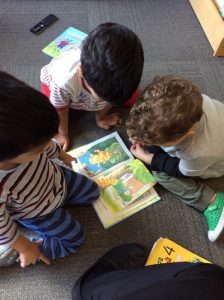
- Language & Literacy:
Beyond age-appropriate books, consider toys like sandpaper letters or magnetic letters that make learning the alphabet an engaging experience.
- Sandpaper Letters: These tactile tools help children connect letters with their shapes, enhancing early literacy skills.
- Magnetic Letters: Perfect for introducing young ones to the alphabet and word-building in an interactive way.
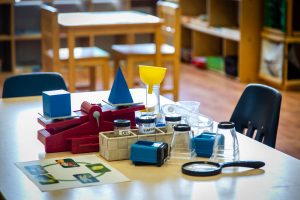
- STEAM (Science, Technology, Engineering, Art, and Math):
With a wide range of options, here are some ideas to explore:
- Science – Magnifying Glass: Spark your child’s curiosity with a tool that opens up the world of exploration.
- Technology – A Digital Microscope: An engaging combination of technology and science, allowing young minds to examine the world up close.
- Engineering – Building Blocks: Wooden building blocks are a classic toy that nurtures creativity and spatial skills.
- Arts – Art Supplies: From playdough to various types of paint and paintbrushes, these tools help children express themselves creatively.
- Math – Math Counters and Math Cubes: Fun manipulatives that make learning math concepts enjoyable.
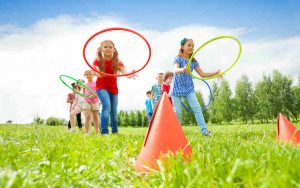
- Physical Activity & Nutrition:
Encouraging physical activity and promoting healthy nutrition for young children is not only vital for their well-being but also a wonderful gift in itself.
- Riding Toys – These encourage physical activity (whether a bike or a riding car)
- Pretend Play Food: Encourage imaginative play and teach young ones about nutrition with pretend food sets.

- Mindfulness:
You can never go wrong with gifts that encourage mindfulness.
- Be Kind Cubes: These cubes offer a fun way to teach children about kindness and empathy, important attributes that align with the pillar of mindful awareness.
- Sensory materials or tables: The materials encourage children to use their senses and evoke a sense of calm.
Remember, the best gifts for young children are those that nurture their development and foster their growth through the joy of learning through play.
Practicing mindfulness during this season is a gift we offer both to ourselves and our little ones. So, let’s take it slow, savor every moment of this season, and treasure the magic of the present with our children.
For more information on early childhood education topics, check out my YouTube videos or to book a tour, please contact us.


